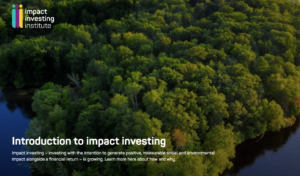ADBI Publication.
Banks must move from climate risk awareness to readiness, embedding adaptation and resilience into core practices.
Key Points
 So, what is impact investing? This module provides the answer and places impact investing in the context of traditional, responsible and sustainable investing. The module also introduces the ‘spectrum of capital’ – a vital aid in explaining impact investing to others – and gives a briefing on the development of impact investing over time and the key global frameworks and standards that govern the market. It also acknowledges some of the challenges that impact investing is addressing as well as the opportunities that are ahead. This section provides the foundational knowledge that you need before you can build your impact skills and expertise.
So, what is impact investing? This module provides the answer and places impact investing in the context of traditional, responsible and sustainable investing. The module also introduces the ‘spectrum of capital’ – a vital aid in explaining impact investing to others – and gives a briefing on the development of impact investing over time and the key global frameworks and standards that govern the market. It also acknowledges some of the challenges that impact investing is addressing as well as the opportunities that are ahead. This section provides the foundational knowledge that you need before you can build your impact skills and expertise.
The Group of Central Bank Governors and Heads of Supervision (GHOS), the oversight body of the Basel Committee on Banking Supervision, has agreed to prioritise further analysis on the financial risk implications of extreme weather events and tasked the Basel Committee with analysing the impact of such events on financial risks. However, a major obstacle for banks is the absence of generally accepted industry models of credit risk adjusted for physical risk factors. This raises the question of whether banks should build their own internal models to account for climate-related adjustments to the internal probability of default and loss-given-default.
Contribution
We propose a way to integrate physical risks into credit risk modelling. Our methodology uses an extension of the model which underlies many internal credit risk models at banks, as well as the regulatory internal ratings-based (IRB) approach from Basel II and Basel III. Physical risk is treated as a single stochastic factor that manifests itself in a binary way with an externally defined probability and a jump in the market value of assets of an individual corporate borrower. A portfolio model is then developed to measure how much physical risk contributes to credit risk losses. Beyond typical uses like economic capital allocation for unexpected credit losses and loan loss provisioning for expected losses, the model could also help banks to manage this new factor of credit risk by hedging it with derivatives on climate-induced damage.
Findings
The model could be of interest for both banks and regulators. Its design and choice of parameters accommodate both a directional climate change (ie climate risk) and weather risk due to increased volatility of climate risk factors. It preserves the so-called portfolio invariance property, ie the invariance of the risk measure for a single credit claim to the composition of the loan portfolio to which it is added. This important property is highly desirable from a practical viewpoint to avoid time-consuming full recalculation of a risk measure on a portfolio level, and because of its potential suitability for regulatory purposes. We also find further possible extensions of the model if physical risk manifests itself in more than one state.
| Cookie | Duration | Description |
|---|---|---|
| cookielawinfo-checbox-analytics | 11 months | This cookie is set by GDPR Cookie Consent plugin. The cookie is used to store the user consent for the cookies in the category "Analytics". |
| cookielawinfo-checbox-functional | 11 months | The cookie is set by GDPR cookie consent to record the user consent for the cookies in the category "Functional". |
| cookielawinfo-checbox-others | 11 months | This cookie is set by GDPR Cookie Consent plugin. The cookie is used to store the user consent for the cookies in the category "Other. |
| cookielawinfo-checkbox-necessary | 11 months | This cookie is set by GDPR Cookie Consent plugin. The cookies is used to store the user consent for the cookies in the category "Necessary". |
| cookielawinfo-checkbox-performance | 11 months | This cookie is set by GDPR Cookie Consent plugin. The cookie is used to store the user consent for the cookies in the category "Performance". |
| viewed_cookie_policy | 11 months | The cookie is set by the GDPR Cookie Consent plugin and is used to store whether or not user has consented to the use of cookies. It does not store any personal data. |